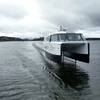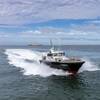First Offshore Exhibition at Maritime Museum Rotterdam
Over forty-five leading companies in the shipping and offshore maritime sector are among those who have contributed to the funding for the first ever exhibition in the Netherlands dedicated to the offshore sector, to be housed at The Maritime Museum Rotterdam for the next seven years. Offshore Experience, which will open in mid-December, will provide visitors with a spectacular overview of the search for oil, gas, wind energy and renewables at sea.
Frits Loomeijer, General Director of the Maritime Museum says, “As the worldwide transition from fossil fuels to renewable energy continues apace, energy assumes increasing importance for the economy and is essential for everyday living. Without energy, we could not recharge our mobile phones, put fuel in our cars or cook our food. A lot of the energy comes from oil, gas or wind and is obtained offshore at sea.
“Dutch companies are in demand throughout the world for the expertise they can bring to complex high-tech offshore projects in the most dynamic conditions. After all, just how do you construct a wind turbine at sea? How do you position a 30,000-ton platform on the seabed, accurate to the centimetre? And how do you prevent gas leaks at 3 km depth? The question for the future is not whether we will be able to drill deeper or under increasingly difficult circumstances, but how we can be more sustainable. In a world where everyone has an opinion on energy, the Maritime Museum is offering its visitors a unique experience around energy production at sea, both now and in the future.”
Visitors to Offshore Experience can witness what it is like to work at sea, perhaps even 3 km below the surface. People of all ages will be able to embark on a challenging search at sea for energy. Wearing a safety vest and helmet, they will experience what it is like to be on an offshore construction in the middle of the sea. A 360° film projection stimulates the senses. Ships come and go and helicopters land. Models of the newest and most advanced offshore ships will demonstrate their capabilities.
Offshore employees will offer a glimpse into their lives at sea, and simulated presentations will enable visitors to experience for themselves how drillers, crane drivers, wind turbine specialists and helicopter pilots undertake their demanding tasks on the open sea, in a constant battle with the elements. A lift will take visitors down to a mysterious undersea world, from just below the surface to a depth of 3 km. The adventure ends in the future, as visitors vote for the best sustainable idea for producing energy at sea.
As well as developing the exhibition, the museum is also expanding the limits of Holland’s maritime heritage by adding offshore to its collection policy. It is carrying out extensive research into the history of the offshore sector in collaboration with Erasmus University and setting an innovative course in terms of technology education and project-funding.
The Offshore Experience has attracted strong support from the commercial sector. Over 45 companies from the offshore sector, plus a large number of other organisations, are financing two-thirds of the project, as well as contributing knowledge and items for the collection. Erwin Kooij, CEO of leading international energy logistics specialist Peterson Offshore Group, says, “We are proud of our sector and I think it’s time to show that to everyone”. Jan-Pieter Klaver, CEO of leading offshore oil & gas industry service provider Heerema Marine Contractors, adds, “The Offshore Experience is a unique opportunity, a challenging way of getting young people to be enthusiastic about technology.”
The Offshore Experience can also be programmed as an educational location for primary, secondary and vocational education. The exhibition is the basis of a new technology education programme in the museum which is in line with the National Technology Pact 2020. This is an agreement under which the Netherlands government and social partners are setting out a long-term approach for increasing the numbers of technically skilled professionals.











